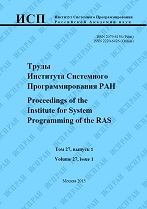|
This article is cited in 2 scientific papers (total in 2 papers)
Modelling the people recognition pipeline in access control systems
F. Gossena, T. Margariaa, T. Gökeb
a Lero - The Irish Software Research Centre, University of Limerick
b SysTeam GmbH
Abstract:
We present three generations of prototypes for a contactless admission control system that recognizes people from visual features while they walk towards the sensor. The system is meant to require as little interaction as possible to improve the aspect of comfort for its users. Especially for people with impairments, such a system can make a major difference. For data acquisition, we use the Microsoft Kinect 2, a low-cost depth sensor, and its SDK. We extract comprehensible geometric features and apply aggregation methods over a sequence of consecutive frames to obtain a compact and characteristic representation for each individual approaching the sensor. All three prototypes implement a data processing pipeline that transforms the acquired sensor data into a compact and characteristic representation through a sequence of small data transformations. Every single transformation takes one or more of the previously computed representations as input and computes a new representation from them. In the example models presented in this paper, we are focusing on the generation of frontal view images of peoples' faces, which is part of the processing pipeline of our newest prototype. These frontal view images can be obtained from colour, infrared and depth data by rendering the scene from a changed viewport. This pipeline can be modelled considering the data flow between data transformations only. We show how the prototypes can be modelled using modelling frameworks and tools such as Cinco or the Cinco-Product Dime. The tools allow for modelling the data flow of the data processing pipeline in an intuitive way.
Keywords:
Visual Modelling, Face Recognition, People Recognition, Computer Vision.
Citation:
F. Gossen, T. Margaria, T. Göke, “Modelling the people recognition pipeline in access control systems”, Proceedings of ISP RAS, 28:2 (2016), 205–220
Linking options:
https://www.mathnet.ru/eng/tisp30 https://www.mathnet.ru/eng/tisp/v28/i2/p205
|

| Statistics & downloads: |
| Abstract page: | 113 | | Full-text PDF : | 82 | | References: | 35 |
|




 Contact us:
Contact us: Terms of Use
Terms of Use
 Registration to the website
Registration to the website Logotypes
Logotypes








 Citation in format
Citation in format 
